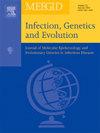Viral integration and fusion transcript characteristics of possibly high-risk HPV in cervical cancer
IF 2.6
4区 医学
Q3 INFECTIOUS DISEASES
引用次数: 0
Abstract
HPV34, HPV66, HPV73, and HPV82 are classified by the International Agency for Research on Cancer as possibly high-risk HPV (pHR-HPV) types. Despite their relatively lower pathogenicity, some cervical cancer (CC) patients have been found to be infected with pHR-HPV, though the underlying pathogenic characteristics remain unclear. Using viral integration detection and RNA sequencing in 8 pHR-HPV+ CC samples, we identified that the integration of pHR-HPV into the human genome and the formation of pHR-HPV-human fusion transcripts are critical events in cervical carcinogenesis. These events disrupt normal gene expression and favor the stable expression of oncogenes. Additionally, we discovered that pHR-HPV undergoes alternative splicing from the AGGTA motif. Despite their lower pathogenicity, pHR-HPV integration may represent a significant risk factor for CC development. Our findings underscore the importance of considering pHR-HPV infections in future HPV screening strategies and clinical management of cervical lesions, especially those associated with HPV integration.

宫颈癌中可能高危的HPV病毒整合和融合转录物特征
HPV34、HPV66、HPV73和HPV82被国际癌症研究机构列为可能的高危型HPV (phrr -HPV)。尽管它们的致病性相对较低,一些宫颈癌(CC)患者被发现感染了phrr - hpv,尽管潜在的致病特征尚不清楚。通过对8个pHR-HPV+ CC样本的病毒整合检测和RNA测序,我们发现pHR-HPV整合到人类基因组中并形成pHR-HPV-人融合转录物是宫颈癌发生的关键事件。这些事件破坏了正常的基因表达,有利于癌基因的稳定表达。此外,我们发现pHR-HPV经历了AGGTA基序的选择性剪接。尽管它们的致病性较低,但phrr - hpv整合可能是CC发展的重要危险因素。我们的研究结果强调了在未来HPV筛查策略和宫颈病变临床管理中考虑phrr -HPV感染的重要性,特别是那些与HPV整合相关的病变。
本文章由计算机程序翻译,如有差异,请以英文原文为准。
求助全文
约1分钟内获得全文
求助全文
来源期刊

Infection Genetics and Evolution
医学-传染病学
CiteScore
8.40
自引率
0.00%
发文量
215
审稿时长
82 days
期刊介绍:
(aka Journal of Molecular Epidemiology and Evolutionary Genetics of Infectious Diseases -- MEEGID)
Infectious diseases constitute one of the main challenges to medical science in the coming century. The impressive development of molecular megatechnologies and of bioinformatics have greatly increased our knowledge of the evolution, transmission and pathogenicity of infectious diseases. Research has shown that host susceptibility to many infectious diseases has a genetic basis. Furthermore, much is now known on the molecular epidemiology, evolution and virulence of pathogenic agents, as well as their resistance to drugs, vaccines, and antibiotics. Equally, research on the genetics of disease vectors has greatly improved our understanding of their systematics, has increased our capacity to identify target populations for control or intervention, and has provided detailed information on the mechanisms of insecticide resistance.
However, the genetics and evolutionary biology of hosts, pathogens and vectors have tended to develop as three separate fields of research. This artificial compartmentalisation is of concern due to our growing appreciation of the strong co-evolutionary interactions among hosts, pathogens and vectors.
Infection, Genetics and Evolution and its companion congress [MEEGID](http://www.meegidconference.com/) (for Molecular Epidemiology and Evolutionary Genetics of Infectious Diseases) are the main forum acting for the cross-fertilization between evolutionary science and biomedical research on infectious diseases.
Infection, Genetics and Evolution is the only journal that welcomes articles dealing with the genetics and evolutionary biology of hosts, pathogens and vectors, and coevolution processes among them in relation to infection and disease manifestation. All infectious models enter the scope of the journal, including pathogens of humans, animals and plants, either parasites, fungi, bacteria, viruses or prions. The journal welcomes articles dealing with genetics, population genetics, genomics, postgenomics, gene expression, evolutionary biology, population dynamics, mathematical modeling and bioinformatics. We also provide many author benefits, such as free PDFs, a liberal copyright policy, special discounts on Elsevier publications and much more. Please click here for more information on our author services .
 求助内容:
求助内容: 应助结果提醒方式:
应助结果提醒方式:


